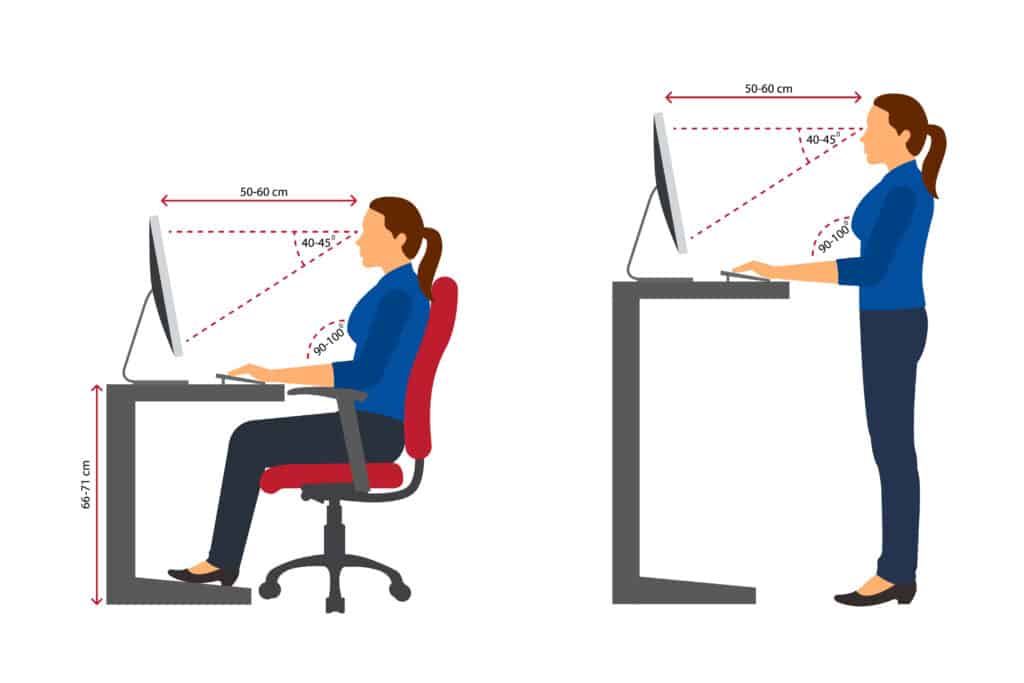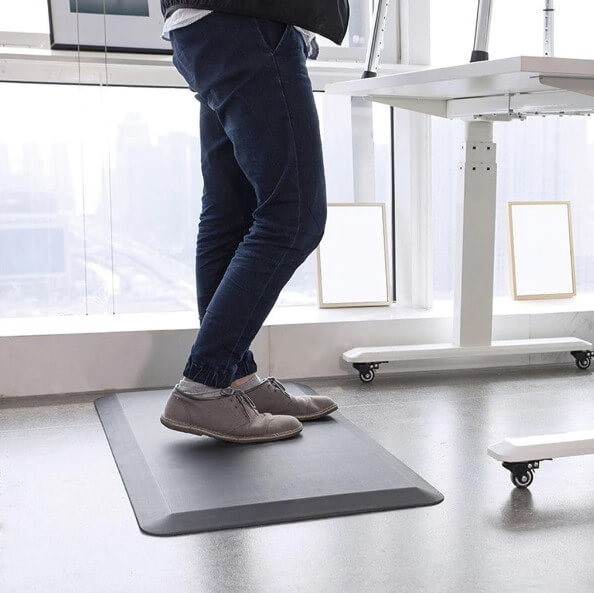How To Transition To A Standing Desk
How to transition to a standing desk is an often overlooked aspect after making a purchase. This is normal, especially if you have been using a fixed-height desk for a long time. After purchasing an Omnidesk Pro 2020 back in February 2022, these are my tips on how to ease into using a sit-stand desk.
Key Takeaways:
- Easing into it by being in a standing position for small periods of time at regular intervals will improve the initial adjustment period.
- Ensure your power cables are long enough when your standing desk is at its maximum height.
- A good quality anti-fatigue mat will work wonders for your feet by providing a cushioned standing surface.
How To Transition To Your Standing Desk
Using a manual or electric standing desk for the first time will take some getting used to. If you are feeling daunted by the prospect, then these steps will help during the transition process.
- Ensure the ergonomic workstation setup is optimal to promote a natural posture.
- Check that your computer power cables are long enough when the desk is at its highest elevation.
- Choose suitable standing desk accessories that increase your personal comfort levels and desk functionality.
- Don’t feel pressured to stand during the first few weeks of buying a standing desk.
- Comfortable shoes or using an anti-fatigue floor mat will help you manage to stand for longer at your standing desk.
- Slowly increase your standing time.
- Introduce stretches into your daily work routine.
- Create a sit-standing schedule to reinforce better working behaviours.
- Timers can help by automatically reminding you to alternate between sitting and standing.
- Pay attention to your body and adjust your standing desk or routine accordingly.
Is It Easy Transitioning To A Standing Desk?
Transitioning to a standing desk from a normal fixed-height desk is relatively easy but doesn’t come without its challenges. During the initial transition period of approximately 2 to 3 weeks, you may find yourself with some discomfort whilst standing since your body isn’t used to it. The ease at which you can switch to a standing desk depends on your physical condition and personal preference for comfort.
Tips On How To Transition To A Standing Desk
The adjustment period for transitioning to a standing desk can be problematic for some. But it doesn’t need to be. Here are a few tips for standing desk users who want to ease into using a manual or electric sit-stand desk.
Tip 1 – Optimise your ergonomics
One of the core reasons why you might have bought an electric standing desk was for the improved ergonomics. This is precisely why setting up your new desk to do exactly that is of primary importance.
Everyone is unique so understanding the key principles of a sound ergonomic set-up is crucial. Essentially, your body should be in an upright and neutral position when seated and standing. In both scenarios, your elbows should be bent at 90 degrees where your forearms are parallel to the desktop.
Positioning your computer monitor at the right height is also important and plays a key role in reducing eye and neck strain.

The most important aspects of a proper ergonomic setup at a standing desk include:
- When seated, your feet should be resting flat on the floor.
- When standing or sitting, arms and elbows should be supported at 90 degrees.
- When seated, the back should be in a neutral position at 90 degrees.
- Your computer’s top third should be where your eyes should be.
- While working, you shouldn’t have to stoop, hunch, or strain your eyes.
Tip 2 – Check your power cables are long enough
It’s rather obvious to position your workstation near a power socket so that you can find the ideal standing desk height. But forgetting about the length of your power cords and cables is often overlooked. If your cables are not long enough, then elevating your sit-stand desk will result in the pins being jammed in the socket.
When you first set up your standing desk, ensure that the cables running to the powerpoint are long enough at the desk’s highest elevation and leave a small amount of slack for those ‘just in case’ moments. If you are cable management conscience or prefer a minimalist working environment, then a cable spine should be at the top of your accessory list. Cable spines neatly house your cords and extend when your desk is elevated. Here’s our list of cable management tips to consider with your standing desk.
Tip 3 – Choose the right accessories
It’s better to purchase standing desk accessories when you make the initial desk purchase so that you save on delivery costs. In addition to the fun and excitement of receiving more items in the post, you get to create your workspace how you want. But knowing which accessories are appropriate for you depends on your personal preferences and environment.
Selecting the right standing accessories will go a long way to improving personal productivity, the level of comfort, and the functionality of your desk. For example, installing a monitor arm will let you easily change the elevation of your computer screen to suit your needs. Some monitor arms also allow you to laterally swing your monitor from side to side which means that you can choose to view the monitor from different positions (e.g. your ergonomic chair while working versus a nearby adjacent sofa to watch Netflix).

Then there are accessories that can be considered essential for every standing desk. For example, the accessory that should be bought with every new standing desk is cable management trays.
Besides adding to the functionality of a standing desk, choosing the right accessories improves the overall enjoyment you get from using a standing desk that has been customised to your individual needs.
Tip 4 – Don’t feel pressured to stop sitting
The first couple of weeks of using a standing desk can be quite the adjustment, particularly if you work in a role that doesn’t require you to venture outside where you can stretch your legs. In saying this, it is absolutely unnecessary to start standing at your desk straight away, and easing into it is a better idea.
Don’t feel like you need to stand during the initial adjustment period. It is perfectly normal to have days where you don’t stand at all.
Tip 5 – Cushion your feet
Staying comfortable and avoiding fatigue is easier said than done after standing. So it makes sense to look after your feet to ensure that the sit-stand desk experience stays enjoyable and has a purpose. While you might be asking whether you should wear shoes at your standing desk, there are two key ways to make sure your feet do not get sore from standing at your desk. You can either wear a pair of comfortable shoes (or thick socks) or invest money into a good-quality anti-fatigue mat.
To relieve stress on your feet, legs, and joints when using an electric standing desk, anti-fatigue mats offer a supportive, cushioned surface for you to stand on. Anti-fatigue mats encourage better posture and circulation while standing for long periods of time by reducing discomfort, particularly in your feet.

In addition to the ergonomic and comfort advantages, an anti-fatigue mat will provide slip-resistant qualities to lower the chance of accidents, insulation from chilly flooring, and noise mitigation to improve the working environment.
Tip 6 – Gradually increase standing time
From personal experience, I can guarantee you that you won’t be standing up at your desk for long periods of time soon after you buy it. Your body just isn’t ready for it yet and there is an element of laziness in the fold. But the health benefits from a standing desk won’t come by not utilising it to its full capacity.
Shorter standing periods will evolve into standing desk success. Start with around 15 minutes every 2 or 3 hours and gradually increase this over a few weeks. The end goal is to stand straight at your desk for a cumulative period of around 3 to 4 hours each day.
However, there is no hard and fast rule. You can also mix things up by using an exercise ball to sit on instead of a chair. Exercise balls offer the extra advantage of training core muscles and can be used for brief durations of sitting.
Tip 7 – Introduce stretching
Stretching can be beneficial when transitioning to a standing desk by helping to alleviate discomfort, improve circulation, and promote overall flexibility. After long periods of sitting, you may have some muscle tension in your lower back and glutes. The same can be said for excessive periods of standing immobile.
Besides feeling good, stretching also promotes better blood flow and reduces discomfort associated with prolonged standing. It helps improve posture and alignment by targeting muscle imbalances caused by sitting, leading to a more upright stance when standing.

By introducing basic stretching exercises into your daily routine, you can increase your energy levels, flexibility and range of motion. As a guide, try to incorporate 2 minutes of stretching for every hour of work.
Tip 8 – Create a daily standing schedule
Once you are accustomed to switching to a standing desk, it’s a good idea to create a schedule that tells you when to switch between sitting and standing. This provides a framework for you to work with and helps to eliminate the likely possibility of being lazy.
Some ideas on a sitting and standing schedule include the following:
- Stand for the first (or last) 15 minutes of each hour.
- 1 hour of standing for every 2 hours of sitting.
- A combination of 1 and 2 above.
- Increasing the duration or frequency of standing at certain times of the day.
Once you’re set on a schedule, it’s a good idea to create reminders in either your mobile device or calendar. This way, you don’t need to think about it.
Tip 9 – Set a timer
With our busy schedules and tasks at hand, it can be easy to forget to change our position from sitting to standing throughout the day. Just set a timer on your phone or computer to be reminded to sit or stand. Eventually, this will become an automatic habit and one that will improve your quality of life while you work.
Some high-end standing desks actually have built-in timers and alarms where you can create your own reminder to change position.
Tip 10 – Listen to your body
Everyone is different so it makes sense to pay attention to any discomfort or fatigue you may experience. If you feel tired or sore, take breaks and switch to sitting if needed and find a balance that works for you.
Because we are all individuals, transitioning to a standing desk is a process of trial and error that will take some time to address. What works for others may not work for you. Each individual’s needs and preferences vary, so be willing to experiment to find the optimal setup for you.
How Many Hours Should You Stand?
There is no set rule on how many hours you should stand for while working at an adjustable-height desk. The goal is to promote movement and better posture through alternating periods of sitting and standing. But as a guide, standing for anywhere between a total of 2 to 4 hours a day will be a good result, depending on your personal preferences. The number of hours spent per day standing doesn’t need to be consistent during the week either. It is normal to have fluctuations between each day.
Frequently Asked Questions
It takes the average person around two to three weeks to properly adjust to using a standing desk. The length of the transition period will depend on factors such as your physical condition, what type of work you do, and personal habits.
Every 30 to 60 minutes, try to alternate between sitting and standing at least once. As a general rule of thumb, the maximum standing hours to stand is 1 hour for every 1 to 2 hours of sitting. This will depend on your personal physical condition, tolerance and comfort level. Standing longer can be bad for you (knee and back pain).
Conclusion
Switching to a standing desk can improve both your productivity and health but using a sit-stand desk for the time may be challenging. You can successfully adapt to this new work style by easing into the new arrangement by gradually increasing the amount of time you spend standing. Self-awareness of good posture is also important in identifying where adjustments may need to be made, and setting a schedule will help you stick to the plan. In short, standing desks are worthwhile using if you make the necessary adjustments.
Related: Tips to avoid regretting your standing desk purchase.